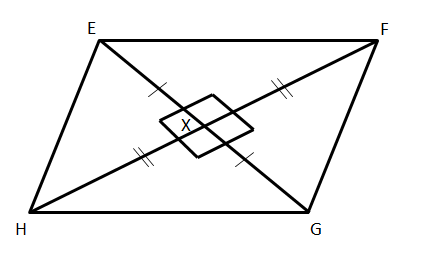
Given $EFGH$ is a parallelogram with diagonals $EG$ and $FH$ meeting at a point $X$. Show that $ar\left( {\vartriangle GXF} \right) = ar\left( {\vartriangle EXH} \right) = ar\left( {\vartriangle GXH} \right) = ar\left( {\vartriangle EXF} \right)$
Answer
551.4k+ views
Hint: Here, we will draw a figure representing the given situation. We will use the fact that the diagonals of a parallelogram bisect each other at right angles. We will then find the medians for their respective triangles. Hence, this will help us to prove that $ar\left( {\vartriangle GXF} \right) = ar\left( {\vartriangle EXH} \right) = ar\left( {\vartriangle GXH} \right) = ar\left( {\vartriangle EXF} \right)$.
Complete step-by-step answer:
We know that , in a parallelogram, the diagonals bisect each other.
This means that since, the diagonals $EG$ and $FH$ intersect each other at $X$. Hence, $X$ is the mid-point of the diagonals $EG$ and $FH$.
Now we will draw the diagram based on the given information.

We know that the diagonals bisect each other at $90^\circ $
Hence, in the triangle $EFG$, $FX$ is the median.
Now, the median of a triangle divides it in two equal triangles with equal areas.
Therefore,
$ar\left( {\vartriangle EXF} \right) = ar\left( {\vartriangle GXF} \right)$……………………$\left( 1 \right)$
Similarly,
In the triangle $FGH$, $GX$ is the median.
Therefore,
$ar\left( {\vartriangle HGX} \right) = ar\left( {\vartriangle GXF} \right)$…………….….. $\left( 2 \right)$
Also, in the triangle $EHG$, $HX$ is the median.
Therefore,
$ar\left( {\vartriangle EXH} \right) = ar\left( {\vartriangle HGX} \right)$…………………. $\left( 3 \right)$
Hence, from the equations, $\left( 1 \right)$, $\left( 2 \right)$ and $\left( 3 \right)$, we get
$ar\left( {\vartriangle EXF} \right) = ar\left( {\vartriangle GXF} \right) = ar\left( {\vartriangle EXH} \right) = ar\left( {\vartriangle HGX} \right)$
Therefore, it is proved that $ar\left( {\vartriangle GXF} \right) = ar\left( {\vartriangle EXH} \right) = ar\left( {\vartriangle GXH} \right) = ar\left( {\vartriangle EXF} \right)$.
Note: A parallelogram is a quadrilateral in which the pair of opposite sides are parallel and equal to each other. Also, each diagonal in a parallelogram divides it into two congruent triangles. The diagonals of the parallelogram bisects each other i.e. when they intersect, they are divided into two equal parts. This means that if the length of the whole diagonal is for example 6 cm then, after intersecting with another diagonal, it gets divided into two equal parts of 3 cm each. Hence, this is an important property of the parallelograms.
Complete step-by-step answer:
We know that , in a parallelogram, the diagonals bisect each other.
This means that since, the diagonals $EG$ and $FH$ intersect each other at $X$. Hence, $X$ is the mid-point of the diagonals $EG$ and $FH$.
Now we will draw the diagram based on the given information.

We know that the diagonals bisect each other at $90^\circ $
Hence, in the triangle $EFG$, $FX$ is the median.
Now, the median of a triangle divides it in two equal triangles with equal areas.
Therefore,
$ar\left( {\vartriangle EXF} \right) = ar\left( {\vartriangle GXF} \right)$……………………$\left( 1 \right)$
Similarly,
In the triangle $FGH$, $GX$ is the median.
Therefore,
$ar\left( {\vartriangle HGX} \right) = ar\left( {\vartriangle GXF} \right)$…………….….. $\left( 2 \right)$
Also, in the triangle $EHG$, $HX$ is the median.
Therefore,
$ar\left( {\vartriangle EXH} \right) = ar\left( {\vartriangle HGX} \right)$…………………. $\left( 3 \right)$
Hence, from the equations, $\left( 1 \right)$, $\left( 2 \right)$ and $\left( 3 \right)$, we get
$ar\left( {\vartriangle EXF} \right) = ar\left( {\vartriangle GXF} \right) = ar\left( {\vartriangle EXH} \right) = ar\left( {\vartriangle HGX} \right)$
Therefore, it is proved that $ar\left( {\vartriangle GXF} \right) = ar\left( {\vartriangle EXH} \right) = ar\left( {\vartriangle GXH} \right) = ar\left( {\vartriangle EXF} \right)$.
Note: A parallelogram is a quadrilateral in which the pair of opposite sides are parallel and equal to each other. Also, each diagonal in a parallelogram divides it into two congruent triangles. The diagonals of the parallelogram bisects each other i.e. when they intersect, they are divided into two equal parts. This means that if the length of the whole diagonal is for example 6 cm then, after intersecting with another diagonal, it gets divided into two equal parts of 3 cm each. Hence, this is an important property of the parallelograms.
Recently Updated Pages
Master Class 9 Social Science: Engaging Questions & Answers for Success

Master Class 9 Science: Engaging Questions & Answers for Success

Master Class 9 English: Engaging Questions & Answers for Success

Master Class 9 Maths: Engaging Questions & Answers for Success

Master Class 9 General Knowledge: Engaging Questions & Answers for Success

Class 9 Question and Answer - Your Ultimate Solutions Guide

Trending doubts
Which places in India experience sunrise first and class 9 social science CBSE

Fill the blanks with the suitable prepositions 1 The class 9 english CBSE

Write the 6 fundamental rights of India and explain in detail

Difference Between Plant Cell and Animal Cell

What is pollution? How many types of pollution? Define it

What is the Full Form of ISI and RAW




